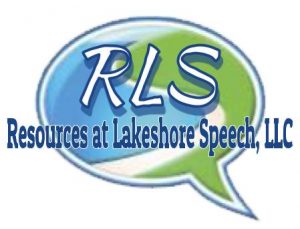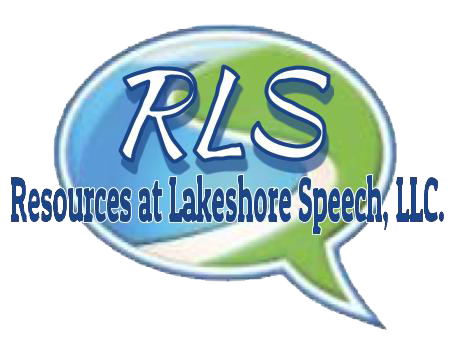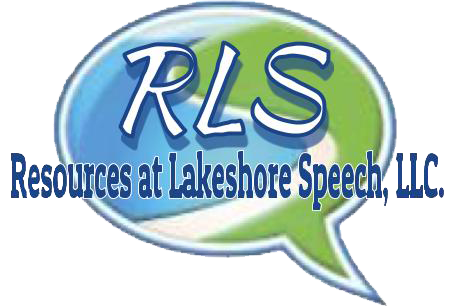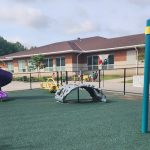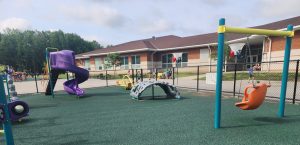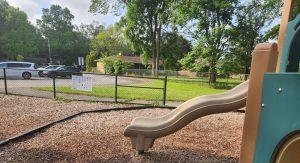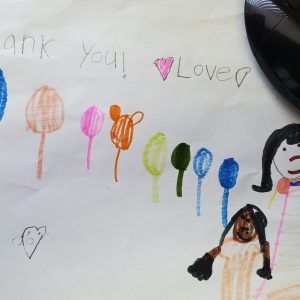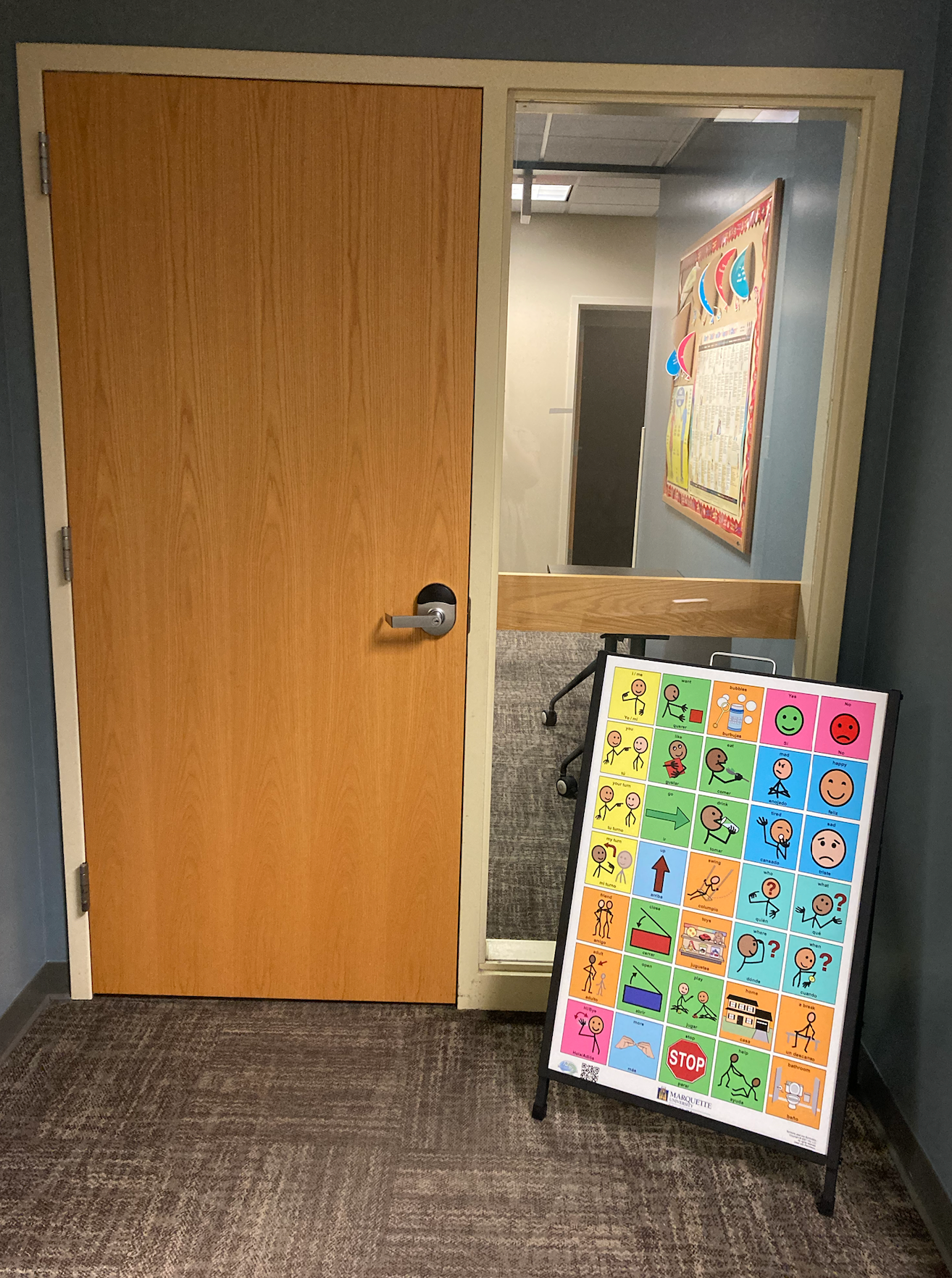
Resources at Lakeshore Speech provides Inclusive AAC Workshop at Marquette University
When most college students spend their summer break lifeguarding, working retail, or scooping ice cream, graduate students in Marquette University’s College of Health Sciences — Speech Pathology and Audiology program — are hard at work in the classroom, pursuing their Master’s degrees.
During this year’s summer semester, Marquette University’s Speech and Hearing Program hosted an innovative guest lecture and hands-on workshop titled “Turning Communication into Connection.” The workshop was led by VernaAnn Kotansky and Ellen Spear, co-founders of Resources at Lakeshore Speech, LLC. Their mission? To help graduate students in the Augmentative and Alternative Communication (AAC) course bridge the gap between textbook learning and community impact.
A Full-Circle Moment
For Ellen, this was more than just a professional collaboration — it was a full-circle moment. As a proud Marquette alumna, she returned to campus not only to teach, but to inspire future speech-language pathologists in the very classrooms where her own career began. She and VernaAnn reflected on their own graduate school days, drawing from shared memories of late-night study sessions, challenging projects, and professors who shaped their professional journeys.
The core philosophy behind the program was clear:
Classroom learning builds the foundation, but applying that knowledge in authentic, real-world situations transforms it into something meaningful.
For Marquette’s graduate students, this wasn’t just about learning therapy techniques — it was about seeing how their future profession could make a difference far beyond the clinic walls.
How It All Started
Between them, Kotansky and Spear share over 60 years of experience as speech-language pathologists. Over the course of their careers, they have worked in schools, clinics, and specialized programs, but they share a common passion: removing barriers to communication in public spaces.
Resources at Lakeshore Speech, LLC designs and sells communication boards for parks, playgrounds, pools, clinics, therapeutic riding centers and other community locations. These boards feature symbols, words, and phrases that allow individuals with communication differences — whether due to autism, developmental delays, speech disorders, or other conditions — to express themselves in shared public spaces.
Their guiding belief is simple yet powerful:
Everyone has the right to communicate, anywhere and anytime.
Why Communication Boards Matter
While physical accessibility in public spaces has improved greatly over the years — with ramps, wheelchair-accessible equipment and inclusive playground design — communication accessibility is often overlooked. A child might be able to physically participate in an activity but lack the tools to connect socially or express needs.
AAC communication boards fill this gap. They:
- Give nonverbal or minimally verbal individuals a voice in public settings
- Foster social interaction between children of all abilities
- Reduce frustration and increase independence
- Promote inclusivity and understanding in the broader community
By installing boards in playgrounds, pools, therapy clinics, and community centers, Kotansky and Spear are expanding the idea of what it means for a space to truly be inclusive.
How AAC Boards Work in the Community
An AAC board is essentially a visual vocabulary. Using symbols and words, the board represents a set of core and fringe vocabulary that allows individuals to point to images or words to express themselves.
For example:
- A child at the pool can point to “I need a break” or “I want a drink.”
- A participant at a therapeutic riding center can point to “Go faster,” “Stop,” or “I’m ready.”
- At a playground, children can point to “Let’s play,” “Your turn,” or “I like that.”
These simple exchanges help bridge communication gaps, allowing everyone to feel heard and included.
Customization Options: Meeting the Needs of Each Community
One of the workshop’s highlights was showing students how boards can be fully customized — at no additional cost — to reflect the needs of the environment and the people using it.
Boards can be tailored for:
- Core and fringe vocabulary relevant to the location
- Preferred symbol systems such as Boardmaker or SymbolStix
- Multiple community languages for bilingual or multilingual settings
- Inclusion of school, municipality, or sponsor logos
Examples of AAC Board Settings
- Clinic – Enhances communication access for clients during evaluations and therapy sessions.
- Therapeutic Riding Centers – Supports interaction between riders, instructors, and volunteers in equine-assisted therapy.
- Playgrounds – Encourages social interaction and cooperative play.
- Pools & Splash Pads – Promotes safety and inclusion in water-based environments.
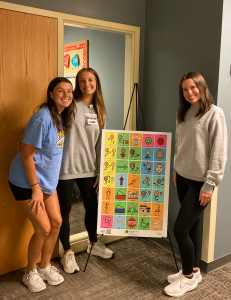
The “Turning Communication into Connection” Workshop
The workshop at Marquette University blended lecture with hands-on experience. Students learned about:
- The fundamentals of AAC and inclusive communication design
- The role of SLPs in advocacy and community engagement
- How to design functional, user-friendly communication boards for public spaces
- Potential SLP career paths outside of the traditional therapy room
Students worked collaboratively to identify underserved public spaces and used templates to design their own AAC boards. The project didn’t end when the class was dismissed — the board they created is now being produced for installation in Marquette’s student clinic, creating a lasting impact on future clients.
Student & Faculty Reflections
The feedback from participants was enthusiastic:
“I really like all the outreach they are doing. It demonstrates the importance of making connections and educating others about AAC.”
“I found it incredible that neither of them had a business background but still made public spaces more accessible for kids!”
“I like how they acknowledged the importance of SLPs being involved in advocacy projects outside of the clinic setting.”
“I didn’t realize how heavily physical needs are being met in spaces but not communication needs — learning about communication boards was eye-opening.”
“As we enter the field, it’s important that we educate peers on our work as SLPs. We are so much more than just articulation!”
“I appreciated how positively, realistically, and passionately they spoke about our profession.”
Why This Matters for Graduate SLP Programs
Graduate-level coursework is intensive and essential — but opportunities like this workshop help bridge the gap between theory and practice. Students see firsthand how their skills can be applied in creative, impactful ways that go beyond traditional therapy settings.
They alsogain insight into:
- collaboration with community partners
- advocating for communication accessibility
- design tools that meet diverse needs
- thinking about their profession on a systems and policy level
Bringing This Opportunity to Your Program
One of the most exciting aspects of Turning Communication into Connection is its accessibility to other programs. The guest lecture and workshop are completely complimentary, with optional board production offered at significantly reduced pricing.
Speech-Langauge Programs benefit from:
- Free board customization (symbols, languages, logos)
- Bilingual options for diverse communities
- Donations back to the hosting program’s department
- A ready-to-use product for clinics, classrooms, or community outreach
Whether you’re looking to enrich your AAC curriculum, inspire advocacy, or give students a creative, real-world project, this workshop offers it all.
Gratitude and Collaboration
This experience at Marquette University was made possible by the support and flexibility of the department chair and AAC course instructor, whose openness to collaboration created a truly enriching opportunity for students.
Take the Next Step
If you’re an AAC instructor, department chair, or speech-language pathology program director, consider adding Turning Communication into Connection to your curriculum this semester.
